Impacts of Different Management Practices on Physico-Chemical Properties of Soil in Mid-Hill, Sub-Humid Zone-II of Himachal Pradesh
Tanvi Kapoor1 * , Ramesh C Chauhan2 and Hukam Chand1
1
Department of Environmental Science,
Nauni, Dr Y.S. Parmar University of Horticulture and Forestry,
Solan,
173230
Himachal Pradesh
India
2
Department of Biology and Environmental Science,
College of Basic Sciences,
Palampur,
Himachal Pradesh
India
Corresponding author Email: tanvikapoor.evs@gmail.com
DOI: http://dx.doi.org/10.12944/CWE.10.3.24
A study was conducted at Hill Agricultural Research and Extension centre Bajaura of CSK HP Krishi Vishvavidayalaya, Palampur, Himachal Pradesh to investigate the Impacts of different management practices on physical as well as chemical properties of the soil. Sample analysis of three management practices i.e. organic, inorganic and integrated revealed that, water holding capacity was found to be highest in organic treatment (50.8%), followed by integrated (44.9%) and least in inorganic (40.2%) whereas field capacity of the three farming systems followed an order as integrated > organic> inorganic treatment. The bulk density of the soil was in the range of 1.36-1.58 Mg cm-2 in the three farming systems and the value was highest in inorganic treatment and lowest in organic treatment. The organic carbon content of soil was highest (1.8 Kg g-1) in organic treatment followed by integrated and lowest (0.75 Kg g-1) in inorganic treatment. The available nitrogen was found to be lowest in integrated treatment followed by organic and inorganic. Cation exchange capacity was found to be highest (16.58 c mol (+) kg‑1) in organic and lowest (10.82 c mol(+) kg‑1) in inorganic practice. Hence organic agriculture practice is best for the restoration of agricultural lands and an environmentally sound and inexpensive way to sustainably intensify crop production on marginal land as well as improving the ecology of the soil environment.
Copy the following to cite this article:
Kapoor T, Chauhan R. C, Chand H. Impacts of Different Management Practices on Physico-Chemical Properties of Soil in Mid-Hill, Sub-Humid Zone-II of Himachal Pradesh. Curr World Environ 2015;10(3) DOI:http://dx.doi.org/10.12944/CWE.10.3.24
Copy the following to cite this URL:
Kapoor T, Chauhan R. C, Chand H. Impacts of Different Management Practices on Physico-Chemical Properties of Soil in Mid-Hill, Sub-Humid Zone-II of Himachal Pradesh. Available from: http://www.cwejournal.org/?p=13297
Download article (pdf)
Citation Manager
Publish History
Select type of program for download
| Endnote EndNote format (Mac & Win) | |
| Reference Manager Ris format (Win only) | |
| Procite Ris format (Win only) | |
| Medlars Format | |
| RefWorks Format RefWorks format (Mac & Win) | |
| BibTex Format BibTex format (Mac & Win) |
Article Publishing History
| Received: | 2015-09-12 |
|---|---|
| Accepted: | 2015-11-17 |
Introduction
The importance of combating environmental degradation in diverse human socio-economic activities has lead to increased calls for a shift to organic farming practices so as to improve the health of soils, ecosystems as well as people. The main idea behind organic farming is 'zero impact' on the environment. Increasing consciousness about conservation of environment as well as health hazards are the major factors that led to the growing interest in organic farming in the world. The organic agriculture practice increases decomposition and build up nutrient status of soil, whereas long time intensive agriculture practice reduced the fertility of soil and loss of diversity of crops. One of the methods of farming introduced by green revolution is inorganic farming which is used widely throughout the world promote the use of synthesized chemicals in the production of crops. Excessive use of chemicals fertilizers and pesticides deteriorated soil health and ultimately made it completely infertile.1 The integrated farming was introduced to minimize and control the detrimental effects of chemical farming and involves the use of low chemical inputs along with organic inputs to fields so as to enhance the crop productivity and protect soil from harmful chemicals. Thus integrated farming is an agricultural system conceived so as to have the least impact on the environment. The soil fertility in organic farming system is managed through crop rotation and green manuring practices. Any changes in organic matter input may affect soil properties, mineral nutrient supply as well as crop yields in different farming systems. Most research suggests that organic practices have improved the soil functions like nutrient cycling. This suggests that recognized beneficial management practices have a bigger impact on the soil fertility as that of land-use system itself. Therefore, in present investigation impact of three farming system on the various properties of soil has been studied and aimed at identifying the best management practice in the region.
Materials and Methods
Study was conducted in the mid-hills sub-humid zone II situated at 31° 51' 0" North, 77° 9' 0" East and at an altitude of 1090 m a.m.s.l. on the farm of Hill Agricultural Research and Extension Centre of CSKHP Krishi Vishvavidayalaya at Bajaura, Kullu H.P. Cropping sequences selected for the study were, French bean- French bean- Cauliflower, Tomato- Cauliflower- Pea and Cauliflower- Cauliflower-Pea. The area receives mild annual precipitation of 1500 mm. The soil is neutral to acidic in reaction; sandy loam and clay loam. The field experiment comprised of three treatments, 100 % organic (50% NPK was substituted by vermicomposting + 50% FYM), 100% inorganic (NPK-20:40:60) and integrated (50% inorganic + 50% FYM). The number of replications were three and the statistical design used was randomized block design (RBD) 2 factorial. Total nine plots of size 4.5 X 4.0 m2 were laid down. Three cropping sequences were taken, Tomato- Cauliflower- Pea (A1), French bean- French bean-Cauliflower (A2) and Cauliflower-Cauliflower-Pea (A3). The recommended dose source of chemical fertilizer NPK for Tomato- 100:75:55, Cauliflower- 125:75:65, Pea- 25:65:65 and French bean- 45:100:30. Surface (0-15cm) and subsurface (15-30cm) soil samples were collected before sowing the crop and after the harvest of crop and analyzed for physical properties such as particle size distribution, bulk density,2 field capacity,3 water holding capacity,2 wilting point3 as well as for chemical properties like pH,4 organic carbon,4 cation exchange capacity8 and available Nitrogen,5 Phosphorus6 and Potassium.7
Statistical analysis
The data generated from the study was statistically analyzed through the procedure as outlined by Gomez and Gomez.9 The design used for the study was randomized block design 2 factorials.
Physical Properties
Soil Texture
The soil was silty-clay loam in the study area. The silt, clay and sand content of the soil were observed as 21.7, 52.4 and 25.9 per cent respectively (Table 1).
Table 1: Particle size distribution
|
Soil textural class
|
Silt |
Clay |
Loam |
|
Silty clay loam soil
|
21.7 |
52.4 |
25.9 |
Bulk Density
Bulk Density of soil was found to be maximum (1.58 Mg cm-3) in the inorganic treatment and the minimum (1.36 Mg cm-3) in organic treatment (Figure 1) which might be due to that organic matter is much lighter than the corresponding mineral matter. The bulk density was found increased in the soil after crop harvesting because the cultivation reduces the organic matter thereby increasing the bulk density. Its value in the surface soil was higher 1.56 per cent than sub surface soil i.e.1.58 per cent.
Field Capacity
The field capacity in the three practices varied in the range of 26.0 to 32.7 per cent (Figure 2). It was observed maximum in integrated treatment (32.7%) followed by organic (30.1%) and inorganic
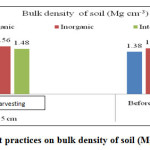 |
|
(28.0 %) respectively. This may be due to the reason that the integrated use of nutrients improve the soil aggregates allowing the free movement of water within the soil thus increasing water content of soil at field capacity.
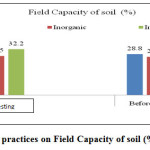 |
|
The value of field capacity increased with depth and also in the after harvesting samples. The results were in line with the findings of Walia et al.10
Water Holding Capacity
The highest (50.8%) water holding capacity of soil was observed in the organic and lowest (40.2%) in inorganic treatment in after harvesting and before sowing samples (Figure 3).
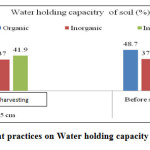 |
|
This may be ascribed to organic matter which has an important role for the changes in the capillary water in soil.
Permanent Wilting Point
The permanent wilting point varied in the three treatments as maximum (20.69%) in integrated treatment followed by inorganic and the least (14.84 %) in organic treatment (Figure. 4). The higher water holding capacity and organic matter content of soil in integrated treatment can be the reason for higher wilting point. Similarly Walia et al. 10 studied the long term effect of integrated use of organic and inorganic sources of nutrients on permanent wilting point and also reported that there is significant improvement in permanent wilting point by applying recommended dose of fertilizers along with FYM. The value of permanent wilting point was found increased in the after harvesting samples.
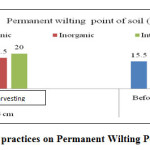 |
|
Chemical Properties
Soil pH
The soil pH (Figure 5) values ranged from 5.4 to 5.9 in the surface soil and 5.4- 5.8 in the sub-surface soil in all the three farming systems. Results revealed almost no significant change in the pH values in different farming systems except organic farming system where it was recorded slightly higher.
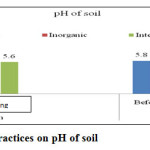 |
|
Cat-ion exchange capacity
Cat-ion exchange capacity was found to be maximum (16.58 c mol (+) kg‑1) in organic treatment and minimum (10.82 c mol (+) kg‑1) in inorganic practice (Figure 6). It is because of the reason that more amount of organic matter accounts for a larger value of CEC.
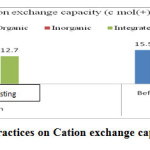 |
|
Organic Carbon
The value of organic carbon in the surface and sub surface soil in before sowing samples were 1.7g/kg and 1.5g/kg respectively and that in after harvesting samples were 1.2 g/kg and 1.1 g/kg respectively (Table 2). It was observed maximum (1.8 g kg-1) in case of organic treatment followed by integrated and minimum (0.75 g kg-1) inorganic treatment, which may be attributed to the FYM optimum C: N ratio for the release of nutrients to the growing plant..The value decreased in the subsurface soil because of the accumulation of organic matter in the surface layers. The results were in line with the findings of Bodruzzaman et al.11
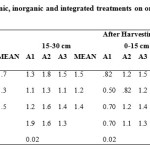 |
Table 2: Effect of organic, inorganic and integrated treatments on organic carbon content (g kg-1) Click here to View table |
- A1, A2 and A3 represents cropping sequences given in material & methods section
- 0-15cm and 15-30 cm are the depths of soil samples
Available nitrogen
The available nitrogen content in the soil before sowing the crop was found highest 485.5 kg/ha in integrated treatment followed by organic (440.4 kg /ha) and it was lowest (393.0 kg/ha) in inorganic treatment (Table 3). The cropping sequence one gave the maximum value of available nitrogen. In another study Gill and Meelu,12 also found that when FYM and inorganic fertilizers are combined it results in an appreciable build up of available nitrogen content of the soil. The amount of available nitrogen decreased in the after harvesting samples as the plant take up some amount of nitrogen from the soil.
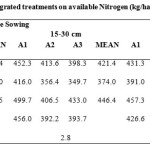 |
|
Available Phosphorous
The organic, inorganic and integrated treatments gave different values for available phosphorous, which varied in a range of 50-70 kg/ha for available phosphorous (Table 4). The maximum amount was observed in integrated treatment followed by organic and the least amount was observed in inorganic. It may be due to the fact that the application of organics along with in-organics increased the organic form of nutrients in the soil and the combined application enhanced the activity of different microorganisms which played an active role in mineralisation and transformation of P. The results are in confirmation with the findings of Singh et al.13
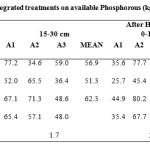 |
|
Available Potassium
The available potassium content of the soil was found to be highest (313.3kg/ha) in integrated treatment and lowest (288.6 kg/ha) in the inorganic treatment it was (Table 5). The value of available Potassium decreased with the after harvesting samples as the plant take up some amount of nutrients from the soil.
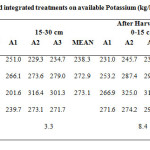 |
|
Acknowledgment
The author is highly thankful to the Head, Department of Biology and Environmental Science, College of Basic Sciences, CSK HP Krishi Vishvavidyalay for all the support and providing all the facilities for completion of the research work.
Refrences
- Hole, D.G., Perkins, A.J., Wilson, J.D., Alexander, I.H., Grice, P.V. and Evans, A.D. Biological Conservation, 122 (1); 113-130 (2005).
- Piper, C.S. Soil and Plant Analysis. (Asian Edition) Hans Publisher, Bombay (1965).
- Richards, L.A. Diagnosis and improvement of saline and alkaline soils .USDA, Hand Book No. 60. Oxford and IBH publishing Co. New Delhi, (1954).
- Jackson, M.L. Soil chemical analysis. Prentice Hall of India Limited, New Delhi, (1973).
- Subbiah, B.V. and Asija, G.L. A rapid procedure for estimation of available nitrogen in soils. Current Science, 25; 259-260 (1956).
- Olsen, S.R., Cole, C.V., Watanabe, F.S. and Dean, L.A. Estimation of available phosphorus in soil by extraction method with NaHCO3, USDA Circ. No. 939; 19-33 (1954).
- Merwin, H.D. and Peech, M. Exchangeability of soil potassium in the sand, silt and clay fractions as influenced by the natyre of the complementary exchangeable cations. Soil Science Society of America proceedings, 15; 125-128 (1995).
- Chapman, H.D. Cation exchange capacity. In : Method of soil analysis Part- II. 2nd edition by CA Black and associates. American Society of Agronomy, Madison, WI, 891-901(1965)
- Gomez KA and Gomez AA. Statistical Procedure for Agricultural Research. John Wiley and sons, New York,(1984)
- Walia, M.K., Walia, S.S. and Dhaliwal. Long term effect of integrated nutrient management of properties of Typic Ustochrept after 23 cycles of an irrigated rice (Oryza sativa) – wheat (Triticum aestivum L.) system. Journal of Sustainable Agriculture, 34 (7); 724-727 (2010)
- Bodruzzaman, M., Sadat M.A., Meisner, C.A., Hossain, A.B.S. and Khan, H.H. Direct and residual effects of applied organic manure on yields in a wheat-rice cropping pattern. Paper No. 781. 17th World Congress of Soil Science 14th-21st August, 2002, Bankok, Thailand.
- Gill, H.S. and Meelu, O.P. Studies on the substitution of inorganic fertilizers with organic manure and their effect on soil fertility in rice-wheat rotation. Fertilizers Research, 3 (1); 303-314 (1982).
- Singh, K.N., Prasad, B. and Sinha, S.K. Effect of integrated nutrient management on a Typic Haplaquent on yield and nurtrient availability in rice-wheat cropping system. Australian Journal of Agricultural Research, 52(1); 855-858(2001).






